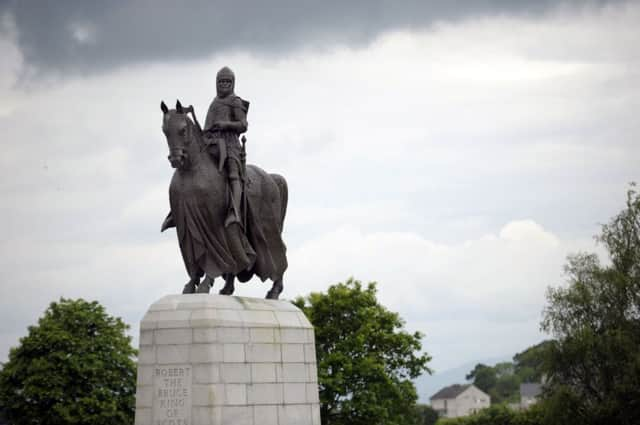Mystery of Robert the Bruce statue teeth solved


More than five decades after he helped create one of the nation’s most iconic statues, a former sculptor’s apprentice has revealed the secret behind the Bannockburn statue of Robert the Bruce.
The cast bronze monument of Scotland’s most famous king has long been a magnet for tourists, with photographs of him striding his steed famous the world over.
Advertisement
Hide AdFor the eagle eyed, however, Charles d’Orville Pilkington Jackson’s statue commemorating Bruce’s famous 1314 victory of King Edward II’s army has long guarded a perplexing mystery inside Bruce’s open face bascinet helmet.
His lower lip, some noticed, seemed to be protruding, while his likeness was missing a few upper teeth.
Now, Hamish Yuile, who assisted the illustrious sculptor in the making of his most enduring work, has told how the statue was designed to show a king scarred by battle.
Mr Yuile was a 16-year-old apprentice sculptor when the firm he was working was was commissioned to make a ceramic replica of the statue. After completing the maquette, he took it and the master mould to Mr Pilkington Jackson’s studio in Edinburgh, where the two men began working on their labour of love.
Over the course of the next year and a half, Mr Yuile, now 68, witnessed first hand the master sculptor’s “meticulous” attention to detail, not least the dental work.
Speaking as he returned to see the statue for the first time in 42 years, he explained: “Mr Jackson, as I knew him, saw some of my own work and took me on. I travelled back and forth to Edinburgh for a year and a half, sometimes sleeping in an army cot in Mr Jackson’s house until the job was complete. He was so meticulous about every detail.
Advertisement
Hide Ad“It’s hard to spot because it’s so high up but Robert the Bruce’s lower lip sticks out. I cheekily asked Mr Jackson why he depicted the King of Scotland ‘missing his upper false teeth’. He said he’d studied Bruce’s skull and forensic scientists believed Bruce had lost his front teeth jousting or in a battle as a young man, so he was convinced Bruce had to look like that at the Battle of Bannockburn.”
Skull
Mr Pilkington Jackson’s preparatory work for the statue was thorough, his former apprentice recalled, and demonstrated a stark realism. Indeed, he even took measurements from the Scottish king’s skull, following the re-discovery of his remains in Dunfermline Abbey in 1818.
Advertisement
Hide Ad“He made an exact replica of Bruce’s skull and sculpted on the muscles, sinew and tissue, and built the image up,” Mr Yuile said. “I was a teenage boy into heroic figures and mythical Norse, Greek and Roman gods, but here was Robert the Bruce with his bottom lip out and missing his top teeth.
“Mr Jackson put me - the cheeky teenager - in my place place and directed me to work on the king’s right foot. That was him getting me to pay fealty.”
Later forensic analysis carried out on Bruce’s skull verified Mr Pilkington Jackson’s gnarled interpretation of the king. Indeed, it is thought Bruce suffered from severe facial deformities in later life, the effect of leprosy.
The statue shows Bruce on the morning of the first day of the battle, before his violent clash with the English knight Henry de Bohun. Completed in 1962, it was unveiled by the Queen in 1964.
Mr Pilkington Jackson died in 1973, aged 85. The year before, Mr Yuill emigrated to the Californian city of San Diego, but even now, he says the recently refurbished statue still has an immense power.
Advertisement
Hide Ad“I was moved at the time and I’m still moved by this statue. I haven’t seen it in over 40 years,” he added. “I was in awe of Mr Jackson because I was an aspiring artist and he took me under his wing and game me gems of wisdom. I’m very proud.”
Scott McMaster, the National Trust for Scotland’s Battle of Bannockburn property manager, said Mr Pilkington Jackson went to “great lengths” to record Bruce as accurately as possible.
Advertisement
Hide AdHe said: “He found out what Bruce would have worn, his armour and what kind of horse he would have been on, as well as the scars he may have had on his face.
“Bruce was a warrior and it is very possible he had his teeth knocked out in battle - he’d have worn it as a badge of honour
“It’s fascinating to hear these stories from Mr Yuile. We’re privileged to have him here for the first time in more than 40 years, as he worked on the statue and was a part of its story.”